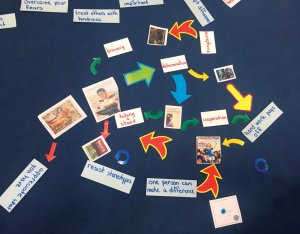Pull Words Off the Page to Promote Learning
Two vocabulary exercises that get students to make connections between words and explain their thinking.
Students need opportunities to research, process, connect with, and use content-area and domain-specific vocabulary beyond simply making a list of words and writing their definitions. Through listening to and connecting with one another via these exercises, your students can take their vocabulary knowledge to the next level.
Interactive Word Wall
This task has opportunities for self-differentiation and allows you to create rich conversations around keywords in all subject areas including math, social studies, reading, writing, science, test prep and more. Students make connections between both words and images (where appropriate) to try out the words’ meanings and relationships to each other. In small or large groups, students' knowledge and misconceptions are brought out in a risk-free environment.
Materials: index cards, markers, and paper arrows
Suggested instructional time: 5–20 minutes (depending on words and grade-level of students) as a warm-up to a related lesson or a stand-alone strategy one to three times per week

Getting started: Identify key vocabulary terms you want students to learn and use with confidence in their writing, speaking, and reading. Find words by looking through books, articles, web resources, and other texts they will encounter. Put those words on index cards.
Implementation: Line up the cards for students to see and either read them out loud or, if students have already done this exercise with the words once, invite partners to warm up by discussing what connections or disconnections they’d like to make. You can start by selecting the first term, or invite a student to choose two words to connect with an arrow and explain how they’re connected. Students call on each other to add a word to the word wall, which grows with each turn. This video shows how it works.
Guiding the process: You can point out to students when they’re repeating ideas, and ask them to move the arrows in a different direction. If students disagree about connections, those can be good points for more discussion. And when students show sufficient understanding, you can remove some words and ask them to add new ones.
Assessment: Stand away from the word wall to observe and take notes, only jumping in to redirect or coach. It’s not my recommendation to teach into misconceptions at this time. Use a checklist to track the words students select as well as any silent signals or notes about students. Since this is mainly student-led, you can gain a lot of information in a short amount of time.
Variations: Once students are familiar with the process, there are a number of ways to enhance the experience. For example:
- Invite students to write key words from the unit or subject area and use their words in lieu of or alongside the ones you identified.
- Take it up a notch by creating an interactive word web. Write two to four big ideas on a large piece of chart paper. Instead of selecting words on cards, students use a marker to write their own words and draw connecting arrows.
- For more complex conversations, consider big ideas that can connect words. For example, when studying Colonial America, students will likely learn about roles of men and women, and survival and interdependence are connecting themes.
Image/Symbol Sorting
When launching a new unit, there are usually many new vocabulary words. Rather than introduce them one by one as a unit progresses, engage the students in an image sort. When you pique their interest with images, students bring their background knowledge and curiosity to the unit from day one. You can prepare for this learning experience in much the same way as an interactive word wall. Gather words and find images and symbols that represent them—your students will make connections between the words that the images represent and the ideas they’re learning about in their reading for that unit. Your students will work in groups, so you’ll need one set of images per group.
Materials: large chart paper or poster board for each group, color or black-and-white images/symbols, markers, scissors, glue
Suggested instructional time: one or two 45-minute periods
Implementation: Set expectations for the learning experience. Groups might be asked to do the following:
- Sort the images into similar groups. What do some images have in common? How do you know?
- Organize the images on a chart with columns, a web, or other method that makes sense to you and your group.
- Quickly jot down your reasoning for grouping certain images together. If others look at your chart, will they be able to understand your decisions?
If necessary, model thinking and sorting for your students to ensure expectations are explicit.
Assessment: The purpose of this vocabulary experience is to engage students as they preview important terminology and tap into their prior knowledge. Assessment will come throughout the unit as students further interact with vocabulary words and make connections as they read.
Tips: For more support, give students headings to use in organizing their sort. Students familiar with the interactive word wall may enjoy creating an interactive web of images. As you confer and move around, ensure groups are going beyond the literal interpretations of the images. After the sort, invite the class to look at other groups’ charts to compare their thinking with others.
Regardless of the strategies you employ, remember to invite students to interact with new vocabulary words. Our goal is for learners to deepen their knowledge on the topic and allow them ample opportunities to internalize their meanings and make connections within and beyond the topic of study.
